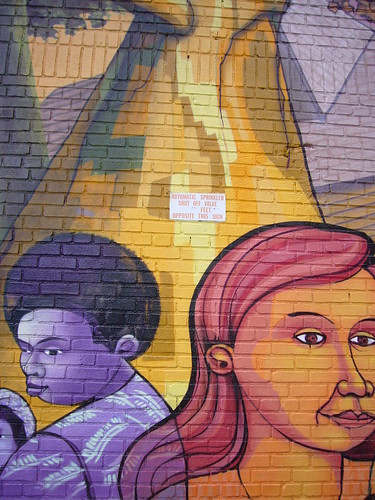Photographing a Ubiquitous Subject
by Camilo Jose Vergara
NPR.org, January 19, 2008 · In the following essay for NPR.org, Camilo Jose Vergara writes about the images of the Rev. Martin Luther King Jr. that he has photographed and how they are beginning to disappear in some places.
In America's poorest neighborhoods, Dr. Martin Luther King Jr. is perhaps the most popular subject of public art, along with the streets, hospitals, schools and housing projects bearing his name. Collectively these have become one of the defining elements of the American ghetto. I believe that they help us understand how people living in poor, segregated urban communities — those about whom Dr. King was most concerned — perceive him and his legacy. They show how inner-city residents use his portrait to feel proud, to sell merchandise, and to develop a sense of security, identity and belonging.
Since 1977, I have been documenting images of Dr. King that regularly appear along the commercial streets and alleys of such cities as New York, Los Angeles, Chicago, Detroit, Camden, N.J., and Baltimore. Many of the murals portraying this civil rights leader are painted on the outside walls of liquor stores, auto-repair shops, fast food restaurants, mom and pop stores, and public housing projects. The majority are the work of sign painters and amateur artists. All of the statues and many of the murals I photographed are located on streets named after him.
Over time I became interested in learning why these images are so pervasive. I feel that they reflect a significant cultural phenomenon: the rise of Dr. King as a central moral figure in poor neighborhoods, and his elevation to secular sainthood as the savior of dispossessed African Americans. His varied representations, often based on photographs taken from the national media, express poor people's perceptions.
After the South Los Angeles riots of 1992, many Latino shopkeepers had Dr. King's portrait painted on the facades of their stores in the hope of staving off the African-American rioters from robbing or vandalizing their businesses.
Wherever they are located, his portraits are usually respected, thus escaping damage and defacement. Sometimes, however, practical considerations result in electric cords emerging from his face, or a closed-circuit TV camera being attached to his ear, or security gates installed over his portrait.
But few of the sign painters hired for portraits of Dr. King have been particularly adept at getting good likenesses, with the result that he often comes out looking Mexican or even Mexican Indian. And now that Latinos in South Los Angeles have become the majority, new images of Dr. King rarely appear while the old portraits of him have been replaced by religious images and specifically Latino subjects.
The phrase "I have a dream" is often written above or below portraits of King. The dream is about justice, equality, three meals a day, housing, education, jobs and peace in the neighborhood. The many images of him in the inner city are powerful reminders to residents to keep pursuing those goals.
Camilo Jose Vergara has been documenting urban America for more than three decades. His work is included in the Berman Collection at the Getty Museum in Los Angeles and in 2002 he won a Macarthur Genius Grant for his photography. He is the author of several books, including How the Other Half Worships.

Mott Haven section of the South Bronx, 1977. Photo by Camilo Jose Vergara.

No comments:
Post a Comment